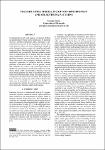Polyrhythmic modelling of non-isochronous and microtiming patterns
| dc.contributor.author | Sioros, G | |
| dc.date.accessioned | 2023-11-14T17:25:28Z | |
| dc.date.available | 2023-11-14T17:25:28Z | |
| dc.date.issued | 2023-11-05 | |
| dc.identifier.uri | https://pearl.plymouth.ac.uk/handle/10026.1/21644 | |
| dc.description.abstract |
Computational models and analyses of musical rhythms are predominantly based on the subdivision of durations down to a common isochronous pulse, which plays a fundamental structural role in the organization of their durational patterns. Meter, the most widespread example of such a temporal scheme, consists of several hierarchically organized pulses. Deviations from isochrony found in musical patterns are considered to form an expressive, micro level of organization that is distinct from the structural macro-organization of the basic pulse. However, polyrhythmic structures, such as those found in music from West Africa or the African diaspora, challenge both the hierarchical subdivision of durations and the structural isochrony of the above models. Here we present a model that integrates the macro- and micro-organization of rhythms by generating non-isochronous grids from isochronous pulses within a polyrhythmic structure. Observed micro-timing patterns may then be generated from structural non-isochronous grids, rather than being understood as expressive deviations from isochrony. We examine the basic mathematical properties of the model and show that meter can be generated as a special case. Finally, we demonstrate the model in the analysis of micro-timing patterns observed in Brazilian samba performances. | |
| dc.title | Polyrhythmic modelling of non-isochronous and microtiming patterns | |
| dc.type | conference | |
| plymouth.publisher-url | https://ismir2023program.ismir.net/poster_82.html | |
| plymouth.conference-name | 24th International Society for Music Information Retrieval Conference | |
| plymouth.journal | Proceedings of the 24th International Society for Music Information Retrieval Conference | |
| plymouth.organisational-group | |Plymouth | |
| plymouth.organisational-group | |Plymouth|Faculty of Arts, Humanities and Business | |
| plymouth.organisational-group | |Plymouth|Faculty of Arts, Humanities and Business|School of Art, Design and Architecture | |
| plymouth.organisational-group | |Plymouth|REF 2021 Researchers by UoA | |
| plymouth.organisational-group | |Plymouth|Users by role | |
| plymouth.organisational-group | |Plymouth|Users by role|Academics | |
| plymouth.organisational-group | |Plymouth|REF 2021 Researchers by UoA|UoA33 Music, Drama, Dance, Performing Arts, Film and Screen Studies | |
| plymouth.organisational-group | |Plymouth|REF 2028 Researchers by UoA | |
| plymouth.organisational-group | |Plymouth|REF 2028 Researchers by UoA|UoA33 Music, Drama, Dance, Performing Arts, Film and Screen Studies | |
| dcterms.dateAccepted | 2023-06-01 | |
| dc.date.updated | 2023-11-14T17:25:22Z | |
| dc.rights.embargodate | 2024-1-10 | |
| dc.rights.embargoperiod |


